During my recent ‘Field Trip’ to Yarra, one of my must-see places was a visit to Coldstream Hills – the label that Australian iconic wine writer James Halliday founded in the 1980s. I’ve been a big fan of Halliday’s writing career, and am keen to take a look at the place where it all started – and taste some wines from this beautiful spot – a legend of the region. Yarra Winegrowers have kindly arranged for me to catch up with Chief Winemaker Andrew Fleming on my first full day in town.
Andrew Fleming: I can give you a snapshot of what the 2023 vintage is looking like, and then we can go down to the Cellar Door and have a look at some finished wines down there. I started here in 2001, so 2002 was my first vintage here. I remember back then, James would write a bi-annual brochure that would go out, and some of his comments weren’t necessarily about the vintage, but more of a grander scale. In 2002 he was talking about screwcaps and he said “unless you’re a museum or a philanthropist – forget about it for reds” because the thought was they would mature so slowly. And then in the next year’s newsletter he said “those of you who read the last one…can chuck it out the window”.
It was a combination of cork taint and the random oxidation that was the killer. Some of the science shows that the amount of air movement through a great cork is minimal – to something that can be a thousand times that. You can talk about a great vintage – but it has also got to be a great vintage for bark – for cork – as well. I remember the 1997 Reserve Chardonnay from here – and you’d see a six pack and you’d say ‘oh this is a nice colour’ and then you’d see one that was really quite developed. And that’s very hard to sell.
And in 1992, which is one of James’ favourite years (and the whites are still amazing now) he had the extra long corks and clearly good quality. We did a tasting late last year, and we looked at Pinot from 1986 onwards, and it was amazing just how well those wines were looking. And the advances since then – not just screwcap, but equipment, techniques, new plantings and vine age. And whether you subscribe to climate change or not, we have clearly seen, over twenty years, a change to the seasons. Like anything, you just have to learn to cope. And we’ve seen our place coping remarkably well. It’s about things like the western side, which gets the dappled light and we don’t need to expose the fruit.
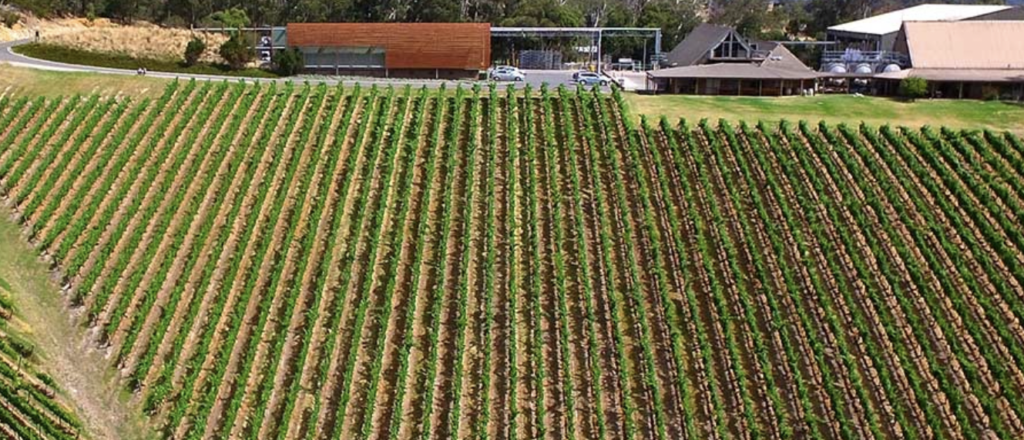
WF: Are there things that are specific to here, and that you’ve had to adapt?
AF: The plants need irrigation – one of the mitigating things that we’re doing now is just looking at what other parts of the Yarra offer. Slightly cooler conditions offer more reliable hedges against drought, but even these soils here have a lot of rock underneath. If you think of the classic Bordelais situation where the roots are down six metres you’ll get that consistency from year to year. Here they don’t get a chance to get down that far. You’ll also see a lot more growing between the vines now – it is not that ‘scorched earth’ policy we had before. What we’ve found is that if you think of those warm years – you’ve got soil that is quite hot and a lot of roots that are close to the surface, so you’re not doing them any favours. And if you’ve got healthy soils, than you’ve got healthy vines. That’s why a lot of growers are looking at under-vine management for cooler soils and better water retention.
WF: What was it like being part of the Halliday phenomenon? As a writer myself, with international experience – I have to say that Hallidays Wine Companion is extremely good. The quality of writing in it is the best, I think, worldwide.
AF: James used to taste all his wines upstairs in The Loft, and he’d do 7000+ wines a year. In his prime he was tasting 280 wines a day and reviewing them. One of the flipsides of that – and this is typical James – he said “every time I go to see my dentist, he’s driving a faster car”. It became this spiral of having to keep going because of the success of it, and it was highly influential. Everyone tries to get into the book in good nick. The irony was, for us, because of his association with Coldstream Hills, it was a liability – you can’t award Winery of the Year to yourself!
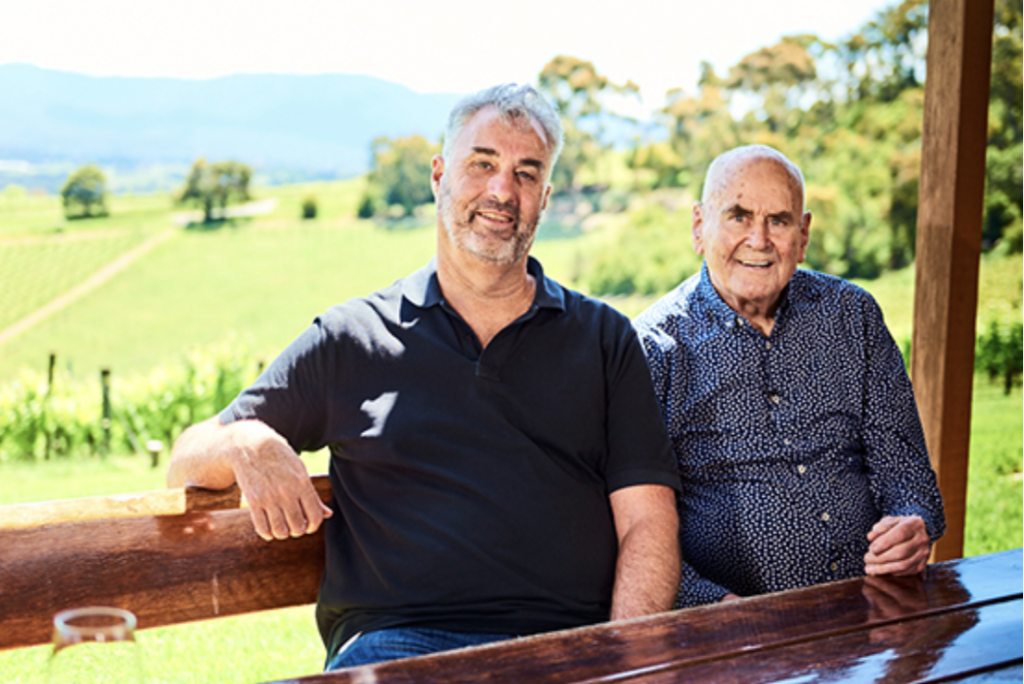
WF: How has this year been – have you finished picking for the year now?
AF: Yesterday was our last day of fruit. The weather was really good up until the last week of March, and we had about 160mms of rain, which is ridiculous. Easter was full on. It’s a combination of what’s the risk out there in the vineyard – are there signs of botrytis, dilutions of flavours and so on. Autumn is normally quite stable for us, but the last however-many years the concern is getting through vintage without the 40-degree day that seems to be the trigger as they put a lot of pressure on what’s out there.
We had terrible bushfires here in 2009, which ironically when you look at the climatic data was a cool year, so it made no sense. Other than the fact that we had no rain, but in mid-February we had three 40+ days and one day with extreme northerly winds. I remember being up here and embers all over the road. At Giant Steps round the corner – they lost part of their vineyard, and it went through a vineyard that we used to own. With this industry you go through these extremes. Dry seasons and wet seasons.
When I first started we picked this vineyard here on 21st March, and now we’ve picked it as early as the 10th of February! That’s dramatic. This year has been two speeds. Up until the third week of March is was pretty solid. Yields weren’t big but it was pretty solid. Then the rain kicked in and it was this stop-start. You’d go hell for leather and then a ten day break.
WF: What do you have planted across the vineyards. I assume it’s plantings for what suits the location?
AF: We’ve got largely Pinot here. Pinot, Chardonnay and a little bit of Cabernet. We have another vineyard round past Giant Steps called ‘Briarston’ which has some pretty interesting Chardonnay – the Bernard clones, which is a pretty important part of the Reserve Chardonnay when we make it. There’s a lot of re-planting going on, and we treat it as an opportunity. I look at this and think we can improve clones, but we have to be able to match rootstock.
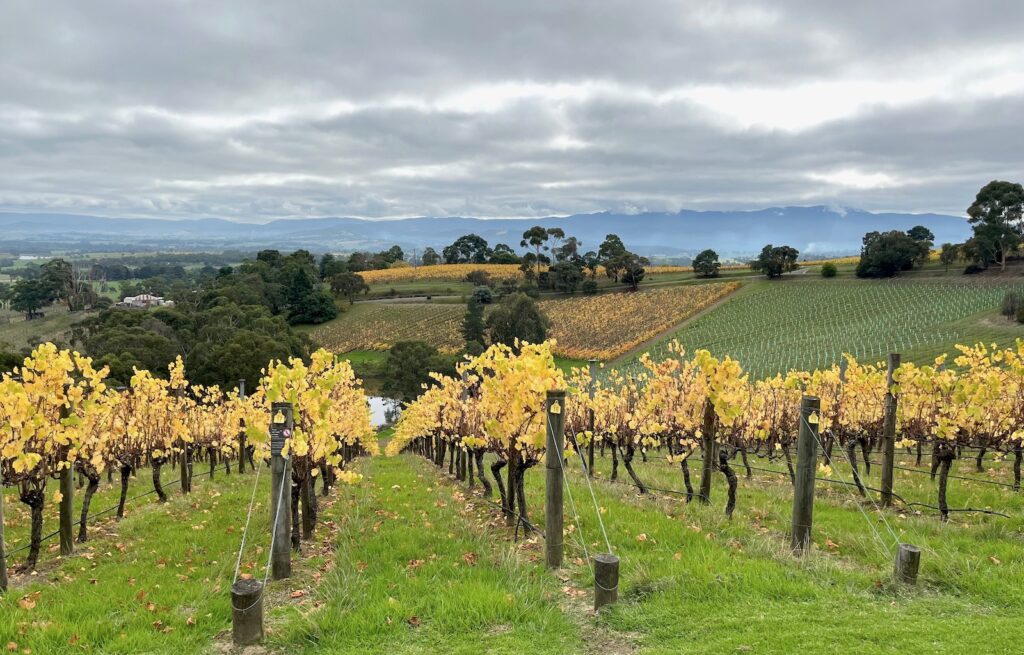
What we call our ‘Upper Yarra’ vineyards are the ‘Deer Farm’ vineyard down towards Gladysdale. Quite elevated and noticeable cooler, wetter. And we have another vineyard directly opposite that which we call ‘Gladysdale’, and then in the last few months we have bought a vineyard from Accolade – as did Giant Steps. They’re in the business mode of divesting quite a bit, and that’s an opportunity for us. Stylistically it will be quite different, but it is a fabulous site. There were six hectares of Pinot Gris which we’ve ripped out! In my mind already I want to have four or five different Chardonnay clones.
WF: I’ve been very impressed so far with the quality that we’ve seen – the standard is very high here.
AF: We’re on the back of a couple of good vintages – albeit not big vintages. 2021 is fabulous in our eyes. One of the best we’ve seen, in particular for Upper Yarra Pinot. ’22 is tiny quantities but really strong quality. There are some winemakers who’ll say ‘the wine makes itself’ and that’s fine. For us, there’s an element of that but there is a lot of just helping along the way. We don’t do malolactic in our whites – since I started. James Halliday’s style was always to have about 15-20% malolactic in his whites. But going back to the idea of ‘warming seasons’ – what’s the point if you start off with lower acidity and put a Chardonnay through a malolactic – then you can add acid back? Doing that can make the wine a little harder and more metallic, so I like the idea of just preserving what’s there!
WF: Is this the original winery?
AF: When James started in 1985 he was buying fruit. The original winery was built in 1988 when Coldstream Hills became publicly listed. The good thing about being part of a greater entity is that we get money invested – we had a 5 million dollar upgrade about ten years ago. In wineries you spend a lot of money on things that use for two months of the year! We tried to spread the place out rather then trying to do everything in the one spot. It’s temperature controlled – we had a really hot vintage in 2008 and had very basic refrigeration so we couldn’t cool things and stuff cooked!
Wynn’s in Coonawarra had just put in a new cellar, so i went over and had a look at what they did, and thought ‘well there’s no point in re-inventing the wheel’ so just put forward a modified version of that, for Coldstream Hills.
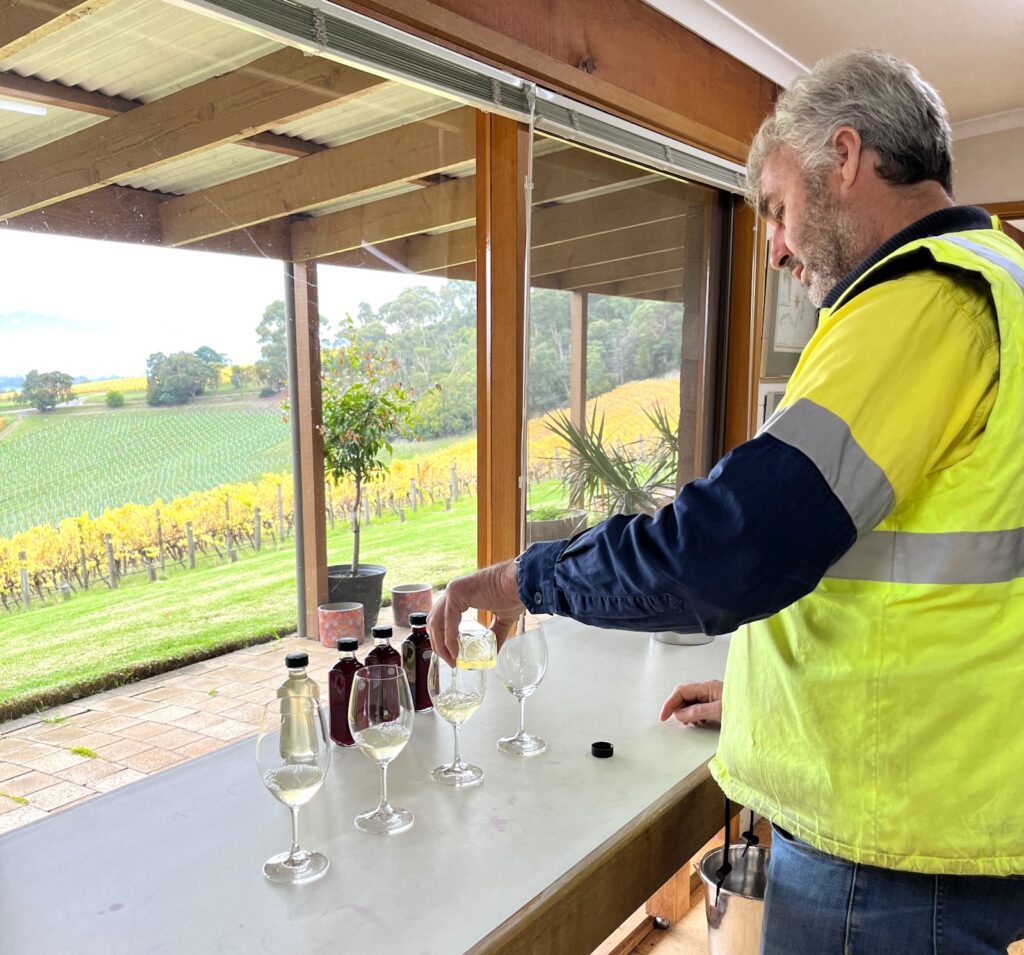
I wanted to show you some wines from the barrels – to save us time, I took samples earlier. This is Deer Farm Chardonnay, which is just out of a couple of puncheons. The way I do this is part in puncheon and the rest in ‘Pam’s Vat’ which is five years old now. I’m not looking for oaky notes – you’re not going to get it. It is more about structure and texture.
WF: There’s a saline juiciness to the acidity – it’s all quite brisk and bright. Is that an Upper Yarra character?
AF: It is – and in cooler seasons, in particular. This is a wine that’s just a month old. It was picked about the second week of March – so it’s a puppy. I love the purity and line – I’m happy with that.
I mentioned the Briarston Vineyard – this has been sulphured up from a one-year old barrel, and I did say that we’ve got a mixture of burgundian clones… so this is 95 clone. Generally this is a Reserve Chardonnay option as the vineyard is east-facing and gives an elegant style. Those Dijon clones provide those aromatics whereas the blocks on the other side of the driveway are a little punchier.
WF: I get this as a little more generous. Nectarine, as well as the lime and grapefruit. Even if you don’t necessarily subscribe to the notion of terroir, it is pretty obvious that a different site is going to give you different characters. And the aim these days seems to be to try and show that.
AF: Totally, and now is that nurturing time where you make sure that barrels are topped, sulphur things up to protect against oxidation and all those things. Now – three Pinots, just to give you a snapshot. First is also from our Deer Farm vineyard in Upper Yarra, and it is looking pretty handy already.
WF: For those, like me, who aren’t so familiar with the region – is there a big difference between the sub-regions here?
AF: There’s always that Upper and Lower Yarra thing. Upper Yarra is more about raspberry and cranberry, rose petal and elegant perfumes. This young wine has an underlying funk and that graphite note from some new barrels. It is, however, not even a month old! Yarra wines, as you can see, are pretty but they have seriousness underneath, and that ageability which is great. We always talk about medium-bodied styles that are great with food.
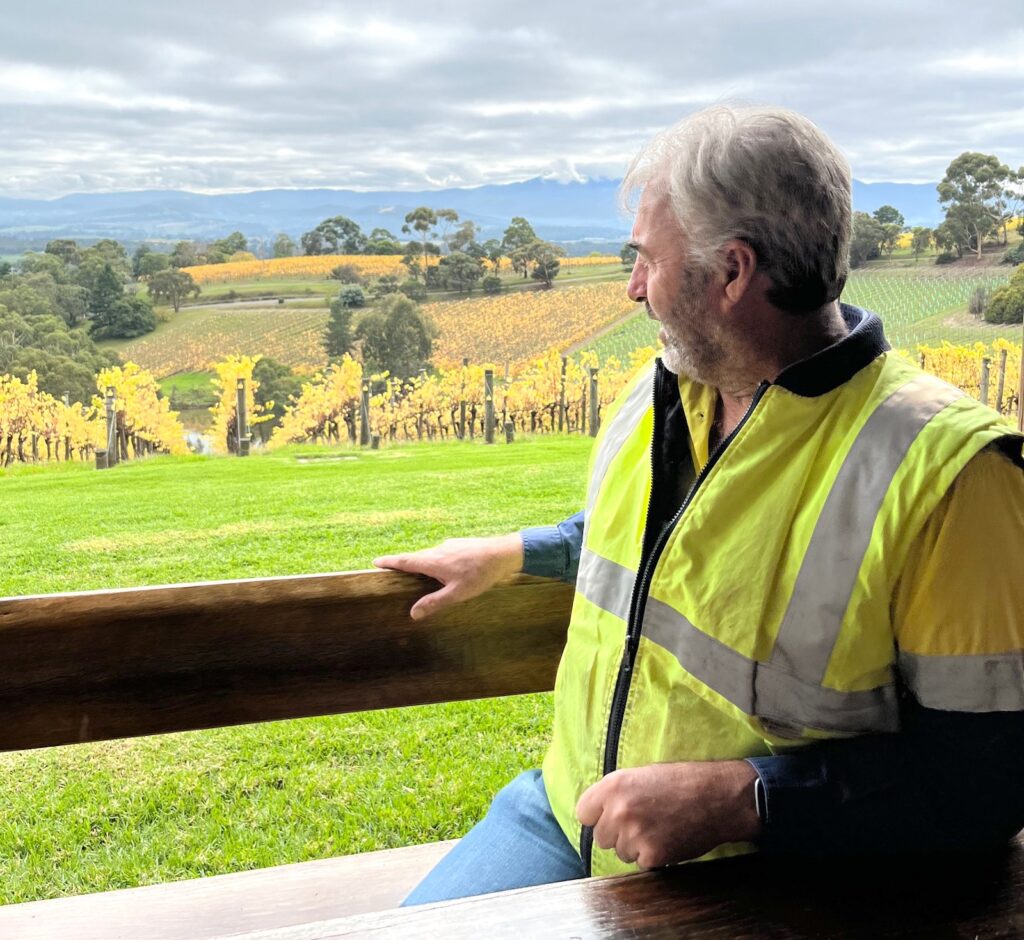
WF: I’m getting a bit of whole bunch in this?
AF: Around 15% whole bunch. The last couple of years we’ve seen a lightness in colour but an amazing vibrancy. For me Pinot is not about colour it is about vibrancy and plushness. As a contrast if we go to the big vineyard that is just on the other side of the driveway. It is a warmer site and we’ll use a little more whole bunch – you’ll see that cherry and plum note coming in. The tannins are a little more grainy.
Finally, this is from a growers vineyard – just on the other side of the hill – called The Esplanade. Always a very savoury, rustic style. We want that diversity. Different vineyards and different styles, and in some years you may not have a huge amount, but if what you have is pretty smart, then it is worth doing. These are new wines – sometimes when you go to barrel and it is this messy, leesy cloudy thing. But the moment it gets a chance to settle down and it gets some clarity, it just takes you in, and that’s one of those magic moments.
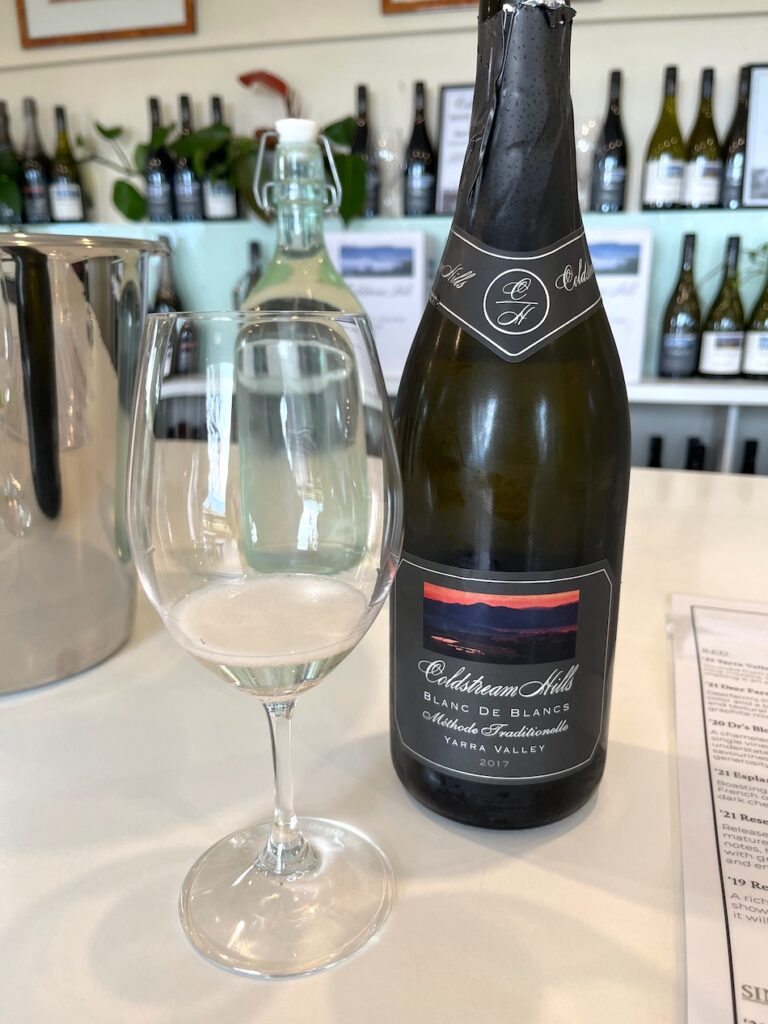
We quickly zip back down the driveway to the Cellar door, to try a few bottled wines…
AF: Not everyone knows that we do sparkling – we’ve only had three releases of this Blanc de Blancs – 2011, 2015 and this one – the 2017. It is five years on lees, and even though it does say ‘blancs’ with an ’s’ on the end, it is essentially 98% Chardonnay with just a tweak of Pinot. We’ve gone a bit lower on the licquer with this – only about 4 grams – for those of you who are interested in numbers.
WF: I knew you did, but I didn’t know it was this good! It’s got a great yeast autolysis to it with bits of mealy, nougat in there – and then a beautiful dry, marmite to the finish.
AF: Let’s also look at the finished wines, that we tried as barrel samples up at the winery – so, Deer Farm Chardonnay and Pinot, and the Esplanade. This is Deer Farm ’21 Chardonnay.
WF: Oh, that’s a cracking wine. There’s a bit of flint and lemon curd going on there. I think back to drinking white Burgundy – when I could afford to, back thirty years ago… and it does help to have had that reference when you then go on to taste, and judge and score wines. Here I am, from the UK, living in New Zealand for nearly twenty years, and looking at some of the best wines from Australia! It’s all a mental library of tastes. That wine fits in with the world of good Chardonnay.
AF: When you line up international Chardonnays against the French, I think the gap is much less. But Pinot there’s still a bit of a gap. Not necessarily quality, but ‘regionality’ more than anything else. But the best of the French just blows your mind when you see some of those things. There was a Brisbane surgeon who would go to Burgundy, and stay in Beaune in a little place we stayed in once. And buy his DRC boxes and leave them there, just taking one or two bottles home with him. He’d sell those bottles and that would pay for his trip the following year! Now you have Deer Farm Pinot, and being Upper Yarra it is all about cranberries, perfume…
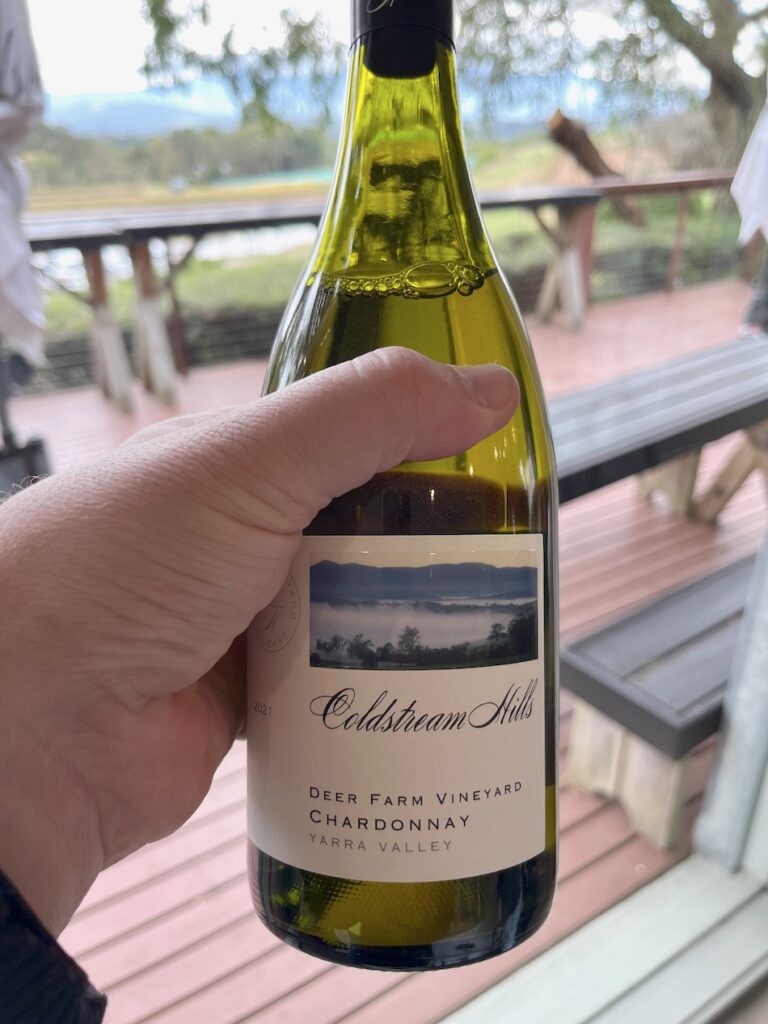
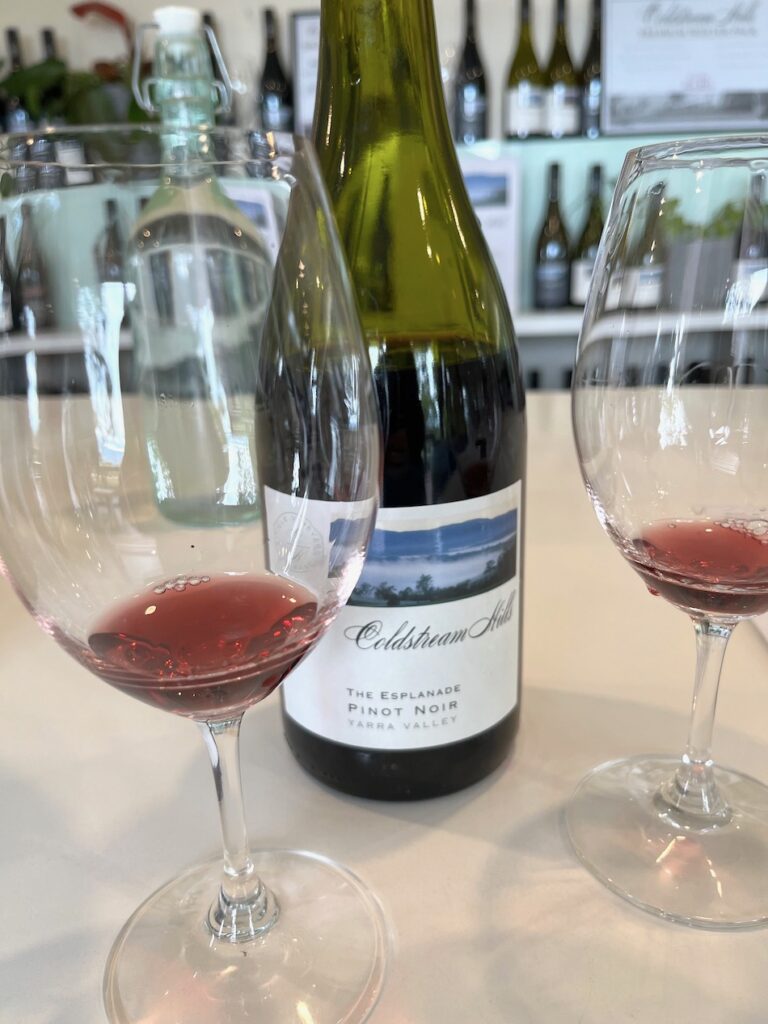
WF: And rose petals and raspberry – right on the nose. The tannins, and a bit of oak, are there but not intruding. It’s a very appealing, elegant style.
AF: One of the things for us, being part of a group, is the oak. For the last fifteen years we do trials, looking at matching oak with Chardonnay and Pinot, and getting out the outliers that might be a bit too angular and just coming back with something that just supports the wine.
What we’re doing here is just delving into Deer Farm Pinot a bit closer, because this is the first time we’ve done single block wines. The wine on the left is ‘E Block’ is the first wine we had up at the winery. About 15% whole bunch and really pretty. And the wine on the right is ‘D Block’ – only about 200 metres away from each other. Looking at difference between blocks and we thought it was worth doing them separately.
WF: That strawberry coulis and red liquorice note in the ‘E Block’, is distinctive! The ‘D Block’ is a bit more reserved – a ‘wait and see’ wine!
AF: And moving down from Upper Yarra – this was the last wine that we tried, which had that rustic, savoury edge to it. You’ll see similarities to that and the Reserve Pinot – just from location!

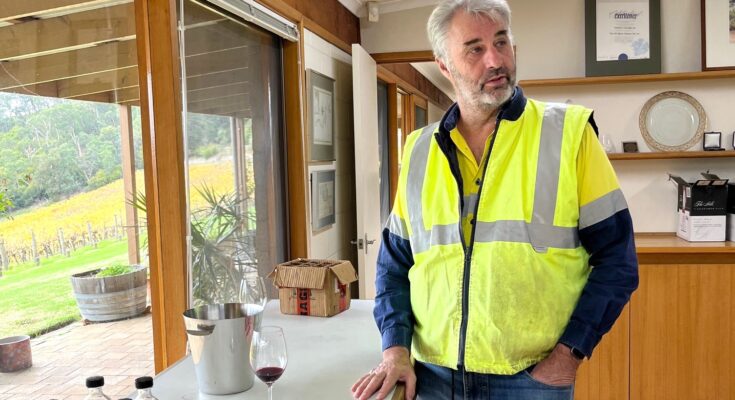
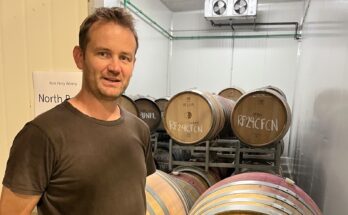
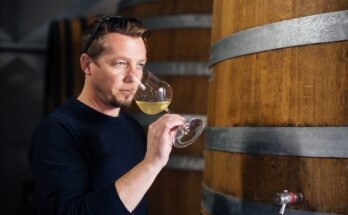
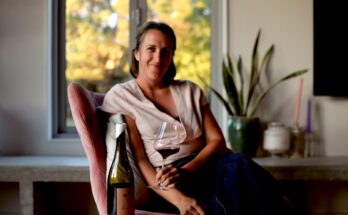
One Comment on “Winemaker series – Andrew Fleming”